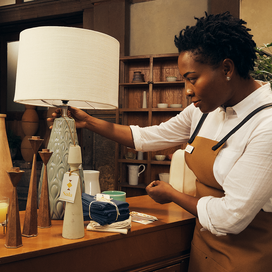Table of contents
Consumers are more invested in wellness and personal care than ever. The wellness industry was valued at over $5 trillion in 2022 and is projected to reach $8.5 trillion by 2027, according to the Global Wellness Institute.
Personal care and beauty (including spas) make up the largest chunk of the wellness economy, and any business that offers at least two self-care services, such as skin care, massage, or salon services, can be classified as a spa.
With a mix of spa services and retail, starting a spa can be a lucrative business model that’s also rewarding. Here’s a step-by-step action plan with everything you need to know about how to start a spa.
Step 1: Come up with a business plan.
The first step to opening any business is developing a business plan. This will be the foundation of your spa business.
The plan is a comprehensive walkthrough, including a description of your business, market information and data, organizational structure, and a financial model. Small business development centers in your area may also have resources and guidance to help you build a business plan.
Research the market: Understand your competitors.
Before you open a spa business, it’s essential to understand what’s happening in the market. Are there other spas already in place?
Perform competitor research to see who your competitors are locally, what they charge, what services they provide, who their clients are, and what’s working for them in their approach. (We’ll look more at spa services in a later section.)
As you conduct your competitor analysis, it’s important to keep these factors in mind:
- Understand competitors’ operations and marketing strategies.
- Identify the strengths and weaknesses of your competition and the overall industry.
- Uncover how customers feel about your competition.
- Develop a competitive strategy catered to your target market.
Having this information will help you better understand what needs there are for your spa and what price points may be attractive for clients.
Organize yourself: Decide on the spa’s business structure.
One of the more technical elements of starting a spa business is thinking about incorporation. You must be a legal business, and there are different business structures to consider: LLC, partnership, or corporation. The type of business structure you choose can impact your taxes, your earnings, and, ultimately, your business’s bottom line, so it’s important to understand the different types of business entities and which makes sense for your spa.
Other structured business needs include licensing. Check with your locality to see if you need a business license and with your state for other spa regulations.
Then think about how you will manage employees. Will you rent booths, hire people to work in the spa, or use a hybrid model to accommodate both types of workers? The business model that works best for you may depend on your past experience and what you’ve learned through your market research.
Select the spa services you’ll offer.
Not all spas offer the same menu of services. Depending on your location and your target customer base, you can focus on a niche area or open a wider menu of services.
- Common types of spas include destination spas, resort spas, medical spas, day spas, club spas, and mineral springs spas.
- If you opt for a niche spa — those that specialize in specific treatment options, such as a mobile spa that brings services to customers — make sure it aligns with the information from your market data.
Once you decide on a spa type, take special care to offer services that potential clients will want most and services with strong profit margins for your business. Use industry data, like the Square Beauty and Wellness Trends report, and consumer insights on particular offerings and services customers want in spas to help narrow down the treatments and services that will help you attract and retain customers and boost your bottom line.
Settle on what spa equipment to use.
Your business plan will also include a list of spa equipment that may be necessary. Equipment can include one-time capital expenses or recurring needs, and will vary depending on what type of services you choose to offer.
Here’s an example starter list of equipment a new spa may consider: tables, chairs, massage tables, towels, washer/dryer, oils, lotion, shower supplies, eye/face masks, exfoliating/hair removal/esthetician tools, wax warmer, and office equipment.
Determine your client profile.
Every business needs a strong client base to be successful. Your business plan will help you create a profile of who those clients are and what your target audience looks like.
Conduct market research to understand what demographics you want to appeal to. That might include a younger or older audience, women, men (male attendance at spas is steadily increasing), or an upscale versus a more casual vibe.
Create an outline of the characteristics that your target audience has that you can reference to help make ongoing business decisions.
Brand yourself: Pick a name and an identity.
One of the questions you will ask when thinking about how to start a spa is, “What do I want my business name to be?” It’s important to think of a name and branding that will resonate with your audience.
For a spa business, it can be important to include “spa” in your business name so people (and search engines) know exactly what you do. Then you need to develop a logo and set of brand assets, including typefaces, colors, and imagery, to use for your business.
Finally, you’ll develop messaging that describes your brand and other materials, such as business cards and signage, to showcase your brand to others.
Add retail to your spa.
Plan to go one step beyond spa services by adding a retail component to your spa business. Selling products can increase your overall profits by adding additional revenue streams.
Whether customers want to purchase products used during their spa service or spend time browsing a retail boutique within your spa, offering retail products is a great way to encourage customers to spend more during their appointment and return to your spa for specific offerings.
If you plan to add retail to your spa, consider options such as Square for Retail, which can help you transact in person and online.
Market your new spa.
When thinking about how to open a spa business, one of the big challenges is getting the word out about it. That’s where marketing comes in.
Think about what channels will resonate most with your target audience, and create a plan for highlighting your spa on those platforms. You may use a mix of social media, traditional print materials, signage, ads in local media, or Square Go, which is a marketplace for beauty and personal care businesses to get discovered by clients.
Calculate your startup expenses.
Starting a new business comes with some costs that you will have to pay before you ever see your first client. Create a budget to account for how much money you will need to open your spa.
While startup costs can vary by location and what services you plan to offer, you’ll want to look at things like business registration fees, rent, construction costs, furniture, utilities, equipment, inventory, supplies, staff payroll, a website, marketing, and legal expenses.
Follow our full guide to business startup costs for a detailed breakdown of expenses to account for as you start your spa business.
Identify how to finance your new spa business.
Don’t be discouraged when thinking about startup costs; there are places to find the capital you need to get started. That’s part of the reason a business plan is so important, since it’s a roadmap you can show investors or lenders to help them understand the business and your goals.
Outline a plan for where your funding will come from, including a breakdown of those financials. Funding options include:
- Personal savings
- Help from family or friends
- Financing for materials or equipment
- SBA loans
- Square Loans
Estimate your business size.
Here’s the aspirational part of a business plan: Think about the size of your spa business today and how you plan to grow.
Create a table in your business plan that includes columns for today, two years, and five years from now. In each column, estimate how many staff members you plan to have, revenue, and percentage goals for growth. You can make adjustments over time, but this outline can help you determine exactly what you are working toward with your spa business.
Step 2: Find your ideal location.
Once your business plan is in place, find a community and location that will allow your spa business to thrive. The location you choose should match the type of clients you hope to attract and provide visibility for the business.
There are a handful of factors to consider when choosing a location for your business, including your budget, your competition, and specific zoning regulations or government incentives that may come into play. The SBA (Small Business Administration) is a helpful resource for researching and making decisions about where to open your spa business.
Once you’ve narrowed down the area and you begin looking at physical spaces, it’s time to consider the equipment and technology you’ll need in your spa. As we covered above, what equipment is necessary to run your spa? Will the space accommodate all the equipment you need, and if you have plans to grow, will the space allow you to do that? It can be helpful to revisit your business plan at this stage to determine if a space truly aligns with your goals.
Step 3: Evaluate which spa booking and management software to use.
Spa equipment is one part of the equation, but you’ll need powerful, reliable software to efficiently run your spa. It’s important to find a tool that will work for your business needs and that allows your business to grow and add on more tools as needed without having to swap tools in the future.
When it comes to the tools and technology you and your staff will need to run your spa, consider important operations like:
- Scheduling appointments, managing waitlists, and sending automatic appointment reminders
- Taking payments in person and online
- Managing staff’s payroll, scheduling, and commissions
- Keeping track of each customer’s visits, preferences, and other client notes
- Tracking and managing spa inventory and sales of retail products
- Sending marketing emails or texts to clients
- Accessing an overview of your spa’s data to understand customer preferences
If you plan to open more than one location, you’ll also need spa software that offers multi-location management for the business and your staff, and you may even want to offer perks like pickup, delivery, and shipping.
Square Appointments helps you and your team easily run and manage all of the operations above. Square Appointments offers tools that make booking online easy (something clients love), as well as an integrated point-of-sale system, a booking website, inventory management, sales reports, cancellation fees, a mobile app, and more.
Integration of other Square tools (like an online store) allows you to manage your business and sell products and services across platforms and wherever clients find your business — whether that’s online, on social media, or through marketing campaigns.
Step 4: Create your online presence.
An online presence confirms your business credibility and helps people find your physical location. Plus, it is a great marketing tool.
Start with a Google Business Profile and set up Google Reviews. Reviews are one of the most important reference points for consumers who are making a decision about visiting your business for the first time. A Google Business Profile also helps customers find your business in Google searches.
Then create a spa website that further solidifies your business credibility. This website should include your location, products and services, photos, staff bios, and online booking options.
Step 5: Design a stellar spa experience for your clients.
A stellar spa experience is what will keep clients coming back and help you find long-term business success. Here are a few elements to keep in mind as you create your spa experience:
Display products to enhance sales.
Plan for a retail display near the checkout that aligns with your spa business. Self-care products are a great way to upsell clients and keep them coming back for products that help them carry the spa experience home.
Provide lockers that have enough space.
If you plan to have a changing area or locker room for clients, don’t skimp on locker size. Lockers should be large enough for clients to store valuables cleanly and securely in a place where they can be monitored by staff for security.
Give clients the right ambiance with calm lighting and music.
Create the right vibe for your target audience with calming, relaxing music, soft lighting, and an overall atmosphere of relaxation and luxury.
Provide luxurious touches.
Adding small, luxurious touches to your spa can make a difference in the client experience. Clients want to feel pampered when they come in for spa services, so consider offering small, luxury perks like a drink menu, weighted blankets, lavender-scented eye masks, or whatever else makes sense at your spa and helps elevate the client experience.
Step 6: Hire, train, and retain the right staff.
Finally, the right team is essential to taking your spa business to the next level. Take time to hire staff to ensure you are matching staff to the services you need your spa to provide.
Look for employees with proper licensure for your business location, and set a plan and schedule for compensation, including base pay and/or commission. Once you find the right people, onboard staff with proper training. This is where it’s important that your salon tools and technology are intuitive and simple to use, since it can be the difference in getting staff up to speed quickly and easily.
Keep track of your team and help manage everything from schedules and waitlists to resource management with Square Appointments. With helpful, automated features that make team and client management easier — including the ability to manage staff schedules and payroll, require cancellation or no-show fees for clients, and assign rooms or spaces to team members — Square can help you manage your staff without extra time and effort.
Figuring out how to open a spa takes some time and effort, but you aren’t alone. Lean on your network to help you create a solid business plan, decide on the services and offerings that will be the most impactful to your clients and bottom line, and invest in quality tools that will help you run the business smoothly.
About Square Loans
Square Loans, LLC and Square Financial Services, Inc. are both wholly owned subsidiaries of Square, Inc. Square Loans, LLC d/b/a Square Loans of California, LLC in FL, GA, MT, and NY. All loans are issued by either Celtic Bank or Square Financial Services, Inc. Square Financial Services, Inc. and Celtic Bank are both Utah-Chartered Industrial Banks. Members FDIC, located in Salt Lake City, UT. The bank issuing your loan will be identified in your loan agreement. The individual authorized to act on behalf of the business must be a U.S. citizen or permanent resident and at least 18 years old. Loan eligibility is not guaranteed. All loans are subject to approval.
![]()













